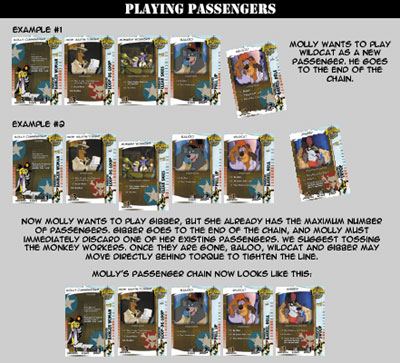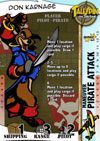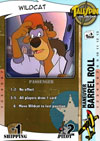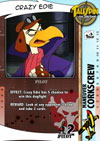 |
||||||
 |
 |
 |
 |
 |
|
|
|
|
|
|||||
Download the entire rulebook in PDF format.
Version 1.1 |

CHARACTER CARDS

Players Players have a die effect table on them, showing the possible results of a six-sided die roll. Die effects are rolled during Step 3 of your turn. Players also contain a unique maneuver that is used when they start dogfights.
Passengers Passengers are played during Step 2 of your turn phase, and are always played to the table immediately behind either your Player card or your last played Passenger. This forms a Passenger priority chain that determines the order in which to apply die effects. Passengers may not be re-ordered unless a game effect allows it. Many effects will force the discard of your last Passenger in the chain, so it is important to protect your most useful Passengers by finding ways to shift them to the beginning of your chain. Each player has a maximum of four Passengers. To take on a new Passenger after you have reached your max, you must play the new Passenger at the end of the chain and then immediately discard any other Passenger in your chain.

Remember, you may not re-arrange your Passengers in the chain unless a card effect allows you to do so. However, if Passenger #2 is discarded, the remaining Passengers immediately shift up and fill the empty space.
Pilots Some Pilots have effects that change the rules of the dogfight they started. These effects are only active for the duration of this dogfight. To help distinguish between Passenger cards and Pilot cards, check the keywords below the card artwork. Also, Pilots have a darker card background. Card Types continued on the next page. |
|||||||||
|
<: card types |
card types 3 :> |

TaleSpin and all related elements copyright the Walt Disney Company.
Card game design and website copyright Joe Fourhman 2004. Bookmark www.fourhman.com/talespin
This page last updated:

 These cards represent you in the game world and cannot be discarded. Each Player has a base level in the three stats: SHIPPING, RANGE and PILOT. The stats indicate the Player's natural skill in the three areas. SHIPPING deals with the ability to cargo; a Player's SHIPPING must meet or beat the given Location's RECEIVING score to play cargo at that Location. RANGE shows how many Locations in either direction that your Player can start a dogfight. Your PILOT skill is your character's overall prowess and translates to the number of cards you may draw at the beginning of a dogfight.
These cards represent you in the game world and cannot be discarded. Each Player has a base level in the three stats: SHIPPING, RANGE and PILOT. The stats indicate the Player's natural skill in the three areas. SHIPPING deals with the ability to cargo; a Player's SHIPPING must meet or beat the given Location's RECEIVING score to play cargo at that Location. RANGE shows how many Locations in either direction that your Player can start a dogfight. Your PILOT skill is your character's overall prowess and translates to the number of cards you may draw at the beginning of a dogfight.
 Passenger cards add effects and abilities to your Player character. They generally contain bonus versions of the three stats, meaning that they add their value to your Player's. Passengers also have a die effect table.
Passenger cards add effects and abilities to your Player character. They generally contain bonus versions of the three stats, meaning that they add their value to your Player's. Passengers also have a die effect table.
 Pilot cards are played during Step 2 of your turn. A Pilot card starts a dogfight against any opponent, regardless of the opponent's Location. Your Player's RANGE does not apply to dogfights initiated by a Pilot card. Pilot cards have a PILOT numerical skill and may contain a Reward. Rewards are collected if you win the dogfight. See the
Pilot cards are played during Step 2 of your turn. A Pilot card starts a dogfight against any opponent, regardless of the opponent's Location. Your Player's RANGE does not apply to dogfights initiated by a Pilot card. Pilot cards have a PILOT numerical skill and may contain a Reward. Rewards are collected if you win the dogfight. See the